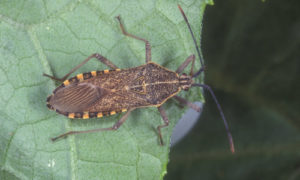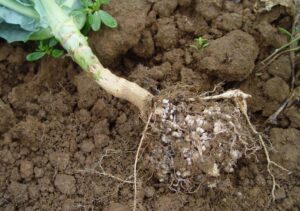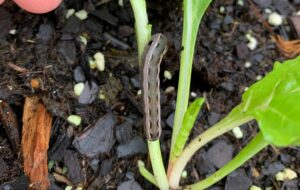Worms are a welcome addition to most gardens. Not only do they improve soil structure and drainage, but they also improve soil fertility. But not all worms are considered beneficial. In this article, you will learn about the hammerhead worm, also known as the hammerhead flatworm, and why it is not something you want to see in your garden.
What is a Hammerhead Worm?
The hammerhead worm is an invertebrate whose head, like that of the hammerhead shark, is said to resemble the head of a carpenter’s hammer. Others describe the head as more spade-like. Regardless of how it is described, the worm’s distinctive head makes it easily identifiable.
The hammerhead worm is a land planarian, which means it has another identifiable characteristic, a flat body.
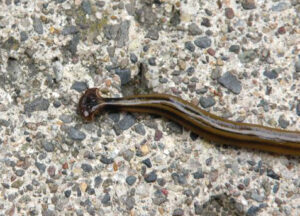
The uniquely shaped worm belongs to the Bipalium genus. (Bipalium is Latin for spade or shovel.) The more common species, Bipalium kewense, measures between six and twelve inches long, while another species, Bipalium vagum maximu, is small by comparison, measuring only two inches in length. Both species have a dark lateral stripe down the middle.
In all, there are some sixty-two species in the Bipalium genus. They range in color from gray to brown, to yellow gold to green. Each species is characterized by its head shape, length, color, and pattern of stripes. But each possesses a “creeping sole” that is used for movement.
In addition to being called hammerhead worm and hammerhead flatworm, it is also referred to as hammerhead slug, arrowhead worm, shovelhead worm, and broadhead planarian.
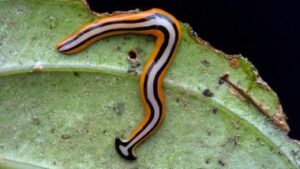
Predatory Hunters
Hammerhead worms are predatory carnivores that track their prey using chemoreceptors located under their heads. They capture their prey by wrapping their bodies around their victims and secreting a slime containing tetrodotoxin. This neurotoxin is the same toxin found in some marine life, like pufferfish and the blue-ringed octopus. Once the worm immobilizes its prey, it extends its pharynx to secrete digestive enzymes that liquify its captive’s tissue so it can be ingested. The predatory planarian prefers to feast on earthworms, slugs, insect larvae, and other flatworms.
Habitat
Hammerhead worms need high humidity, which is why they live in cool, damp locations like under rocks and logs. They are also light-sensitive and prefer to feed at night. If you do see them, it will most likely be after it rains. In the winter, they stay underground until warmer weather returns.
Hammerhead worms are native to Southeast Asia. They are believed to have been introduced to the United States in the early 1900s, most likely by hiding in imported plants and landscaping materials. Unfortunately, it has not taken long for this invertebrate to colonize warmer, humid regions like the southern coastal states.
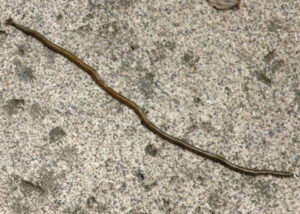
Why They Pose a Threat to Your Garden
Hammerhead worms pose a real threat to you and your garden for several reasons.
Invasive Carnivores
First, they are invasive, carnivorous creatures that threaten to eliminate the much-needed earthworms. Earthworms play a vital role in the health of garden soil since they help decompose organic matter, provide soil aeration, incorporate soil amendments, and provide natural fertilization. Land planarians, on the other hand, do not provide such advantages. Without the beneficial earthworms, diminished soil fertility will lead to the loss of crop vitality.
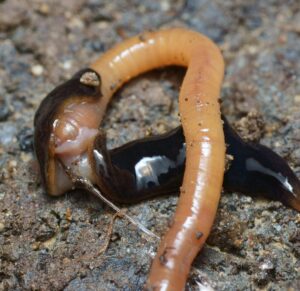
Transmit Harmful Nematodes
Second, in addition to the loss of beneficial earthworms, hammerhead worms can transmit harmful nematode parasites that adversely affect plant health.
Toxic if Touch or Ingested
Third, if you touch one of these toxic terrestrials, it will cause skin irritations and temporary tingling or numbness. Animals that ingest one of the worms will feel nauseous for a day or two.
Rapid Reproduction and Regeneration
Fourth, the hammerhead worm multiplies rapidly either by procreating or by regeneration. They are hermaphrodites, meaning each worm has both male and female reproductive capabilities. Thus, they reproduce both sexually and asexually, with the latter being the more common method. (Earthworms are also hermaphrodites, but they usually reproduce sexually.) Eggs hatch in as little as three weeks.
Additionally, hammerheads multiply via regeneration. If a worm is cut into pieces, each fragment can regenerate an entire worm in about ten days. For example, if a fragment of a worm’s head or tail remains, it will regenerate to a complete worm.
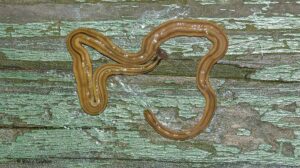
No Known Predators
Last, the land planarian has no known predators because its slimy toxin is a powerful deterrent to any potential enemy. A lack of predators allows this invasive worm to flourish unchecked.
What to Do If You Find a Hammerhead Worm
If you find a hammerhead worm in your garden, you should kill it because it is invasive and poses a real threat to earthworms. It is important to dispatch them properly so that they will not regenerate.
- Carefully pick up the flatworm with gloves, a stick, tweezers, or other tool. Be sure to wash anything that touches the flatworm to remove the toxins.
- Place the flatworm in a plastic bag or some other disposable container that can be sealed.
- Add vinegar and or table salt to the bag and seal it. Each ingredient, or a combination of the two, will kill the worm. You can also add citrus oil to the salt or vinegar. Regardless of which ingredients or combination of ingredients you use, they must come into contact with the worm.
- Throw the sealed bag in the trash.
If you find a hammerhead worm, it is a good idea to routinely inspect your property for more. Also, inspect any new plants or landscaping materials for any invasive worm that might be hiding.
If you live in Texas and you find a hammerhead worm, take a picture before dispatching it, and send the picture, along with your location, to the Texas Invasive Species Institute at invasives@shsu.edu. They are tracking hammerhead worms in the Lone Star state. If you live outside of Texas, send the picture and information to your local cooperative extension office.
Thank you for reading this article! If you found it helpful, please consider sharing it with others via email and social media!

